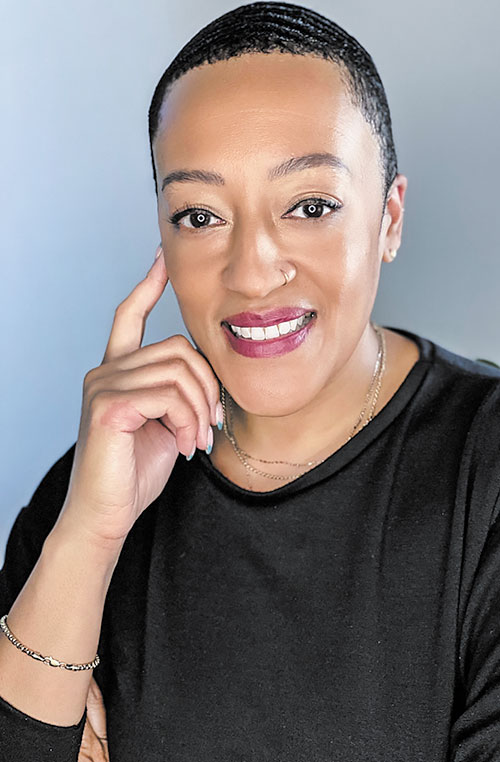Dr. Suzanne Slonim and her wife, Pam Gerber, above, and Teyah Scales, right.
Fibroids affect about half of all women but now can be treated with a minimally invasive procedure
DAVID TAFFET | Senior Staff Writer
taffet@dallasvoice.com
Thanks to the work of Dallas couple Dr. Suzanne Slonim and Pam Gerber, July has been designated Uterine Fibroid Awareness Month in Texas. Slonim is a doctor who specializes in a minimally invasive fibroid procedure that replaces the need for a hysterectomy in most cases. Gerber decided more women need to know they don’t need to live with the pain and discomfort of fibroids that at least 50 percent of women develop.

Teyah Scales
Teyah Scales, Slonim’s patient, said she always had cramps during her cycle, but “I didn’t know it was fibroids. I always had heavy periods.”
In 2018, her doctor told her that she thought she felt something. That began a period of what the doctor called “watchful waiting.”
Her general practitioner found her iron was low, so she began taking pills.
“I thought I was OK,” Scales said. “Then a year ago, my abdomen started feeling full. I could feel a lump in my lower pelvic region.”
Her general practitioner told her she needed an ultrasound and found Scales’ blood count was low.
Scales said she was feeling fatigued. Even a short walk left her breathing fast. The ultrasound revealed fibroids.
“You have so many, we’re not going to count them all,” the tech told her.
Fibroids run in Scales family. Her grandmother had a hysterectomy because of them. Her aunts both had fibroids, and so did her mother. But her mother had a new procedure done more than 20 years ago called uterine fibroid embolization, the procedure Slonim specializes in.
Slonim said fibroids do tend to run in families. Black women are more likely to have them, and stress is a risk factor. She said studies show stress caused by discrimination is of particular concern in the formation of fibroids. So as a Black lesbian who had fibroids in her family, Scales was definitely high risk.
Estrogen fuels the growth of fibroids, so trans men are not particularly at risk of getting them. The hormone treatments a trans man receives cuts off the estrogen, and any fibroid trans man already developed before transitioning would die with the hormone treatments.
Slonim asked Scales if she had ever used hair relaxer, and Scales said she had. The chemicals used to straighten hair also stimulate the production of estrogen, putting Black women who use the product at higher risk, Slonim said.
The UFE treatment Scales received is done by an interventional radiologist like Slonim by inserting a catheter through the blood vessels.
“We inject tiny particles to plug the blood vessels in the uterus,” Slonim explained. “When we cut off the blood supply, the fibroids die and shrink.”
She said that 90 percent of the time, this takes care of all the symptoms.
Scales said that by about a month after the procedure, she felt like a new person.
COVID, Slonim warned, is a factor in fibroid growth. The virus interferes with clotting and more blood feeds the fibroids. Also, she warned, “women who carry excess fat” are at higher risk for fibroids since estrogen is produced in fat cells.
As part of the treatment, Slonim prescribes medication to control the pain and nausea, fever and malaise after the procedure. She sees her patients a week after, then at one month and then three months later.
Scales, who just had the procedure done in April, calls it “life changing.” She said she has her energy back and no longer has a rapid heartbeat.
Fibroids can interfere with fertility, Slonim said, adding that they can cause extremely heavy bleeding and cramping and can affect urinary frequency and urgency. Fibroids may cause bloating, pain during sex and back pain that can run all the way down the legs. Some are big enough that a woman can’t bend over.
While about half of all women develop fibroids, not all are symptomatic.
NAMING A MONTH
“Two years ago, I saw an article that Kamala Harris sponsored a bill to designate July as National Uterine Fibroid Awareness Month,” Gerber said. “I had to be involved.”
So she contacted Harris’ office and got in touch with the staff person who had written the proposed legislation. They spoke, but the legislation was put on hold when Harris was nominated to run for vice president.
But Gerber decided there was something she could do locally. Through former state Rep. Lorraine Birabil, she got in touch with state Rep. Senfronia Thompson. In office since 1972, Thompson’s known as the dean of the House of Representatives.
Gerber worked with Thompson to get a bill passed in the House in the final special session of the last Legislature.
From there, Gerber decided to seek local support for awareness, and she worked with Dallas City Councilwoman Paula Blackmon on a resolution designating July Uterine Fibroid Awareness month in the city of Dallas and with County Commissioner Theresa Daniel to similarly designate the month of July throughout Dallas County.
The Barbara Jordan Leadership Institute is helping to lead the effort to get the word out about Texas Uterine Fibroid Awareness Month. Among the events planned is a self-care fair, a free community event and feminine hygiene supply drive on July 16 from 11 a.m.-3 p.m. at the Fannie C. Harris Youth Center, 4212 E. Grand Ave.
More information about Texas Fibroid Awareness Month is available at TXFAM.org.















